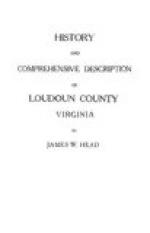A considerable proportion of this soil type is under cultivation, especially on the broad mountain top. Those areas not cultivated are covered with a heavy growth of oak, hickory, locust, and walnut. Corn and wheat can be grown on the type with fair yields, but little of the latter is grown on account of the stony nature of the land. Corn yields from 20 to 35 bushels, wheat from 8 to 15 bushels, and grass and clover from 1 to 2 tons per acre. Irish and sweet potatoes give good yields, and fine apples and peaches are produced. Peaches are liable to winterkill, and the crop is uncertain for this reason. This type is peculiarly adapted to fruit growing, and especially to the production of apples.
Meadow.
The Meadow of Loudoun is usually a brown silty or sandy loam, with a depth of several feet. The type occurs in narrow bands along the larger streams, forming a bottom or low terrace a few feet above the mean water level. The nature of the soil depends greatly on the surrounding soils, as it is formed from sediment of the wash from these types and partakes of their textural characteristics to some extent.
The type, while low and flat, is generally well enough drained for cultivation, although this is somewhat hindered by overflows; consequently the land is chiefly used for grazing. The soil is alluvial in origin, being built up by successive overflows of the streams. Little of the type is forested. Where cultivated it is generally used for corn, which yields from 50 to 75 bushels an acre. Little wheat is grown, although the soil is capable of producing fair yields of this crop. It also produces from 2 to 3 tons of hay per acre, and affords excellent pasturage. The crops are somewhat uncertain, however, on account of overflows which sometimes occur after the planting season, though in the case of the River the danger from flood is usually past before the time for corn planting. Where the areas are in grass the floods usually do little damage. Productiveness is in a great measure maintained by the addition of the sediments left by the overflow waters.
FLORA AND FAUNA.
FLORA.—Records of the days of early settlement point to a scarcity and an inferiority of large timber in Loudoun (then Prince William) and contiguous counties. The responsibility for this condition has been traced to the hunters who frequented this region prior to its settlement and wantonly set fire to the forests in order to destroy underbrush, the better to secure their quarries. A comparatively dense and vigorous new growth followed the discontinuance of this pernicious practice.
At the present time, after the encroachment of field and pasture for nearly two centuries, a large portion of the county’s area is still under forest cover. The stand, in the main, is somewhat above average size and quality.
The total value of forest products cut or produced on farms in 1899 was $51,351. This includes only the wood, lumber, railroad ties, etc., which the farmers cut in connection with their ordinary farming operations. The reports of persons making lumbering or wood cutting their principal business are not included.




